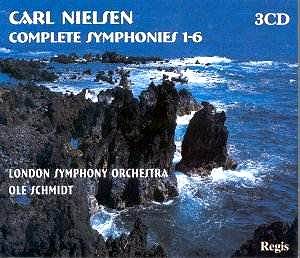This is cause for joy. When, last year, Regis managed to persuade Ole Schmidt to license to them the rights to issue symphonies 4 and 5 from this analogue cycle I wondered whether the company would be able to issue the complete cycle. It has happened!
What is more, if you had already bought REGIS RRC 1036 (symphonies 4 and 5) then you will be able to buy RRC2046 separately. You are not forced into duplicating symphonies 4 and 5. Credit to Regis. Many other companies would choose and have chosen to force collectors into rebuying previously purchased discs.
This set is far more than a nostalgia trip for 1970s vinylophiles out to recapture the 'bite' of those Unicorn LPs. The intemperate virtues of the Schmidt series ring true to this day. Shaggy and gangly, awkward and passionate, crippled and whole this music sings with inexorable passion. Even that Victorian mulch out of which the First Symphony rose is shaken, crazed and ruptured by a 20th century brutality. Would that Schmidt would turn his attention to Louis Glass's Fifth Symphony. He has a real feel for impulse and spontaneity which shines too from the Second Symphony. A certain density of texture afflicts these recordings although this is only really apparent in the tumbling bustle of the collerico first movement. It sits well with the malincolio movement. The sanguineo rushes along impelled by a slight hysteria and goaded onwards by some top-flight work from the brass section. ... and just hear those horns at 02.00 in the finale!
The Espansiva is given a superheated up-draught by Schmidt and by the LSO giving what sounds to be their all. The playing of the brass and percussion is edge-of-seat standard dicing with chaos and yet gripping the outer edge of control. This is music that sounds dangerous not tame. Listen to the opening measures of the Allegretto (III). Through Len Mullenger's kindness I have, since 1998, heard a great deal of music. Few performances have moved me as much as this - the glorious Arthur Butterworth First Symphony on ClassicO, Mravinsky's Tchaikovsky 4, Turnovsky's Martinu 4 are in the same Pretorian league. Bob Auger's work with microphone and mixing desk must take a bow. Almost a footnote - but it took Schmidt to make me realise how close Nielsen is to Rimsky in the finale of Espansiva at 02.43.
Schmidt and the LSO give full rein to the throaty ramping and shuddering gear changes of No. 4. Listen to the irrepressible howl of the horns at 0.17 in the finale. This music has less to do with tragedy than with the expression of the grinding magma tectonics of nature's irresistible life force. The woodwind are played with the necessary coarseness giving that icy-salty savour so essential to the enlivening pulse of Nielsen's music. The percussion have been rendered with more bass impact in other recordings but the famous duel still registers very strongly here.
As a work the Fifth is humanity to the Fourth's nature. It is given a wonderful outing by Schmidt. How well he terraces the dynamic variations and the echoing terrain in the first movement. In the radiant adagio the horns toll in unfeigned glory and the aleatoric cursing of the side drum raps out its disruptive way.
The discomfiting Sixth, which is anything but simple, remains an enigma to this listener and among Nielsen's output occupies a similar place to that of the Fourth Symphony among the Sibelius seven. There are interludes of warmth catching the same summer schemes as the French Horn passages in Symphony No. 5. In addition the pawky humour traces its way to Nielsen's concertos for flute and clarinet. The recording is warm and responds well to the cell-like progress and to the avoidance of weighed down orchestration. I remain unsure of the piece. Interesting that Mark Morris in his invaluable 'Pimlico Dictionary of Twentieth Century Composers' links elements of the Nielsen work with Shostakovich (Symphony 15) and Britten (Grimes). For me there are also moments of Stravinsky (particularly the writing for winds - Petrushka and Symphonies of Wind Instruments) and Malcolm Arnold though the latter came after the event rather than being an influence. The darker Arnold is strikingly foreshadowed in the Tema con Variazioni.
Regis are to be congratulated on a felicitous revival. They have freshened the sound from the original and later issues and restored to us Schmidt's score-cleansed interpretations as blessed by Robert Simpson. The notes are by David Doughty and James Murray. The three discs come in one standard jewel case and one single width double case and both slip into a light card sleeve.
Regis prove that these Unicorn-Kanchana analogue tapes - the first integral Nielsen cycle, pipping Blomstedt and EMI to the post - have but slept. Snap up this bargain set as a matter of urgency.
Rob Barnett
